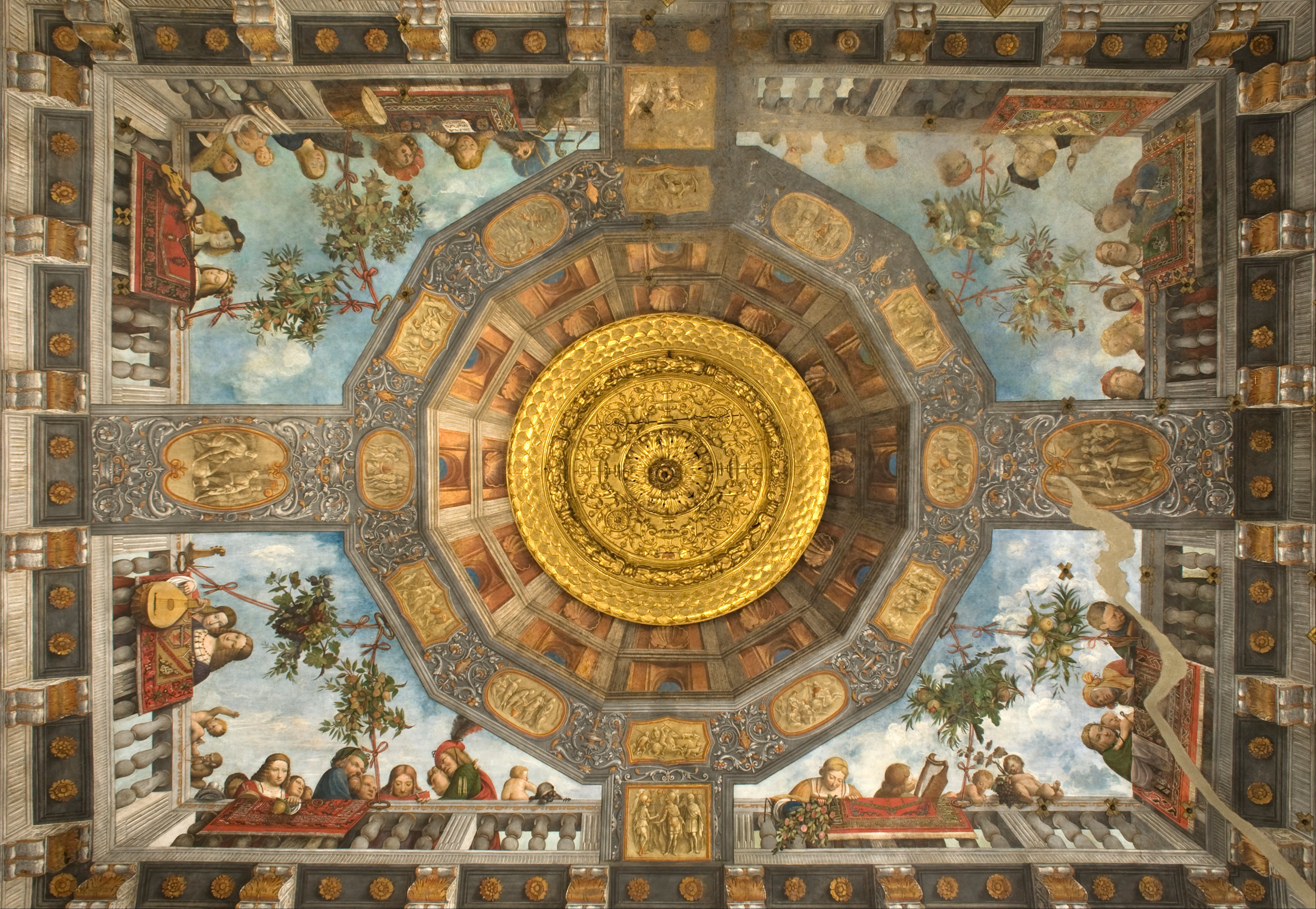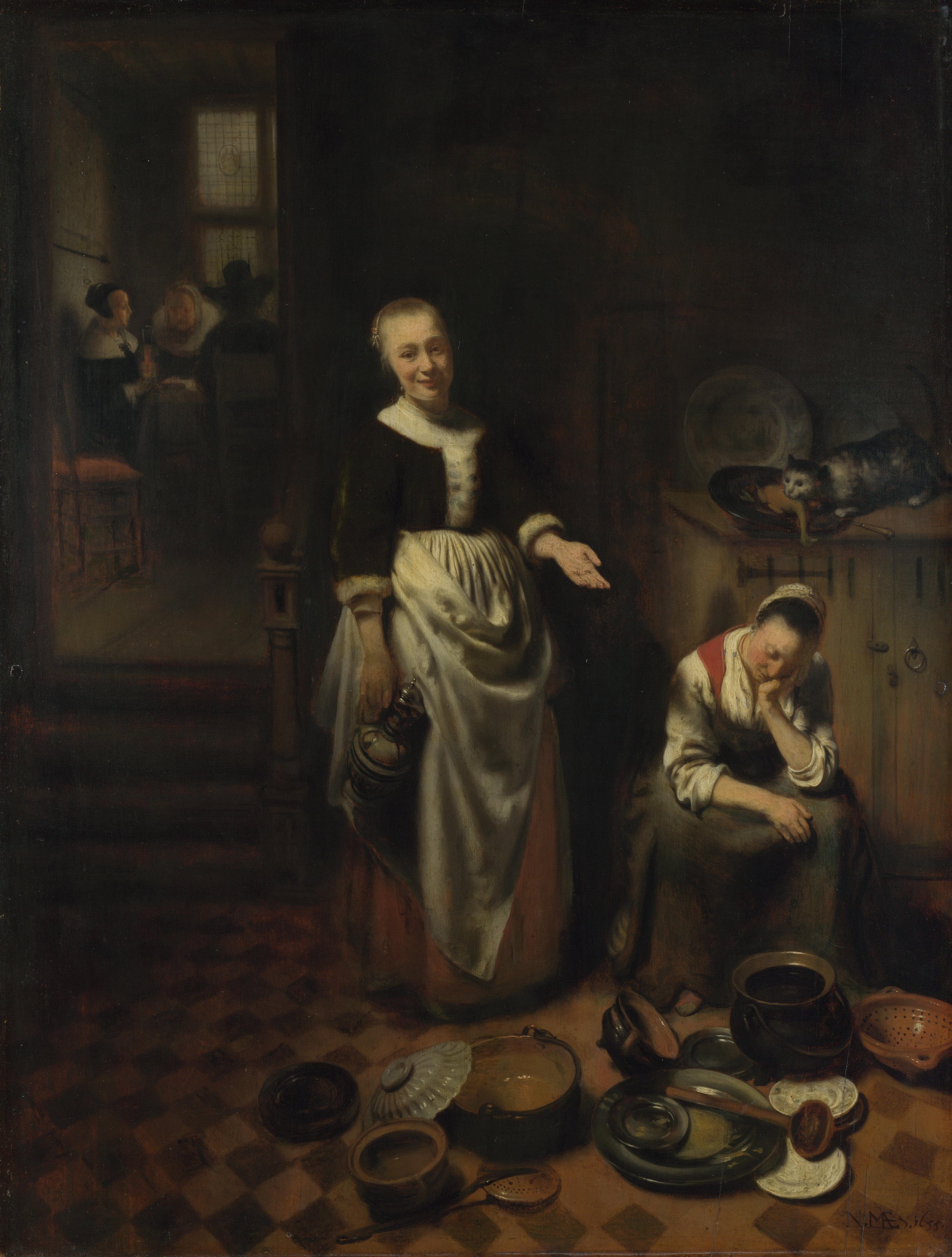|
Fijnschilders
{{Short description, 17th-century Dutch artistic movement The Fijnschilders (literally "fine-painters"), also called the Leiden Fijnschilders ('Leidse Fijnschilders'), were Dutch Golden Age painters who, from about 1630 to 1710, strove to create as natural a reproduction of reality as possible in their meticulously executed, often small-scale works. Although in the seventeenth century, as in modern Dutch, the term ''fijnschilder'' was used to differentiate between a painter practicing classic techniques and one who, for instance, is a house painter, in the nineteenth century it became a label for artists like Gerrit Dou and his followers in Leiden. Dou, Frans van Mieris, Sr. and Adriaen van der Werff—all among the most successful of the Dutch Baroque—became identifiable by their "fine" manner, exquisite techniques, and extreme attention to detail resulting in works with smooth surfaces completely lacking painterly brush strokes. The application of paint contrasts with the text ... [...More Info...] [...Related Items...] OR: [Wikipedia] [Google] [Baidu] |
Dutch Golden Age Painting
Dutch Golden Age painting is the painting of the Dutch Golden Age, a period in Dutch history roughly spanning the 17th century, during and after the later part of the Eighty Years' War (1568–1648) for Dutch independence. The new Dutch Republic was the most prosperous nation in Europe and led European trade, science, and art. The northern Netherlandish provinces that made up the new state had traditionally been less important artistic centres than cities in Flanders in the south. The upheavals and large-scale transfers of population of the war, and the sharp break with the old monarchist and Catholic cultural traditions, meant that Dutch art had to reinvent itself almost entirely, a task in which it was very largely successful. The painting of religious subjects declined very sharply, but a large new market for all kinds of secular subjects grew up. Although Dutch painting of the Golden Age is included in the general European period of Baroque painting, and often shows many o ... [...More Info...] [...Related Items...] OR: [Wikipedia] [Google] [Baidu] |
Dutch Golden Age Painters
Dutch Golden Age painting is the painting of the Dutch Golden Age, a period in Dutch history roughly spanning the 17th century, during and after the later part of the Eighty Years' War (1568–1648) for Dutch independence. The new Dutch Republic was the most prosperous nation in Europe and led European trade, science, and art. The northern Netherlandish provinces that made up the new state had traditionally been less important artistic centres than cities in Flanders in the south. The upheavals and large-scale transfers of population of the war, and the sharp break with the old monarchist and Catholic cultural traditions, meant that Dutch art had to reinvent itself almost entirely, a task in which it was very largely successful. The painting of religious subjects declined very sharply, but a large new market for all kinds of secular subjects grew up. Although Dutch painting of the Golden Age is included in the general European period of Baroque painting, and often shows many o ... [...More Info...] [...Related Items...] OR: [Wikipedia] [Google] [Baidu] |
Godfried Schalcken
Godfried Schalcken (1643 – 16 November 1706) was a Dutch genre and portrait painter. He was noted for his mastery in reproducing the effect of candlelight, and painted in the exquisite and highly polished manner of the Leiden fijnschilders. Life and work Godfried Schalcken was born in Made, North Brabant, the son of Cornelis Schalcken and Aletta Lydius. Before he was four years old, his family moved to Dordrecht, where his father became rector of the Latin school. Schalcke studied under Samuel van Hoogstraten in Dordrecht before he moved to Leiden, into the studio of Gerard Dou (1613–1675), one of Rembrandt's most famous pupils. His earlier genre pictures very closely resemble Dou's work. He worked in Leiden until c. 1675, then returning to Dordrecht until 1691, after which he settled in The Hague, where he continued to paint until his death, near age 63, in 1706. He also visited England (1692–1697), but his uncouth manners and bad temper alienated him from the society t ... [...More Info...] [...Related Items...] OR: [Wikipedia] [Google] [Baidu] |
Gerrit Dou - De Hollandse Huisvrouw
Gerrit is a Dutch male name meaning "''brave with the spear''", the Dutch and Frisian form of Gerard. People with this name include: * Gerrit Achterberg (1905–1962), Dutch poet * Gerrit van Arkel (1858–1918), Dutch architect * Gerrit Badenhorst (born 1962), South African powerlifter and professional strongman competitor * Gerrit Battem (c. 1636 – 1684), Dutch landscape painter * Gerrit Beneker (1882–1934), American painter and illustrator * Gerrit Berckheyde (1638–1698), Dutch painter * Gerrit Berkhoff (1901–1996), Dutch chemist and university rector * Gerrit Cornelis Berkouwer (1903–1996), Dutch theologian * Gerrit Berveling (born 1944), Dutch Esperanto author * Gerrit Blaauw (born 1924), Dutch computer engineer * Gerrit de Blanken (1894–1961), Dutch pottery artist * Gerrit van Bloclant (1578–1650), Dutch Renaissance painter * Gerrit Bol (1906–1989), Dutch mathematician * Gerrit Braamcamp (1699–1771), Dutch distiller, timber merchant and art colle ... [...More Info...] [...Related Items...] OR: [Wikipedia] [Google] [Baidu] |
Stedelijk Museum De Lakenhal
Museum De Lakenhal is the city museum of fine art and history in Leiden, Netherlands. One highlight is its collection of fijnschilder paintings from the Dutch Golden Age. Just like the city, the museum combines a classical appearance with a contemporary character. The broad collection ranges from early works by Rembrandt van Rijn and Lucas van Leyden's Last Judgement to modern classics of De Stijl and artworks created by contemporary artists such as Claudy Jongstra, Atelier van Lieshout and many others. History of the building The museum building was erected in 1640 by Arent van 'Gravesande as a cloth hall ''(lakenhal in Dutch)'' – a guild hall for cloth merchants. The museum was founded in 1874 as a ''stedelijk'' museum (municipal museum.) Collections Like other municipal museums in the Netherlands, it became a repository for municipal art collections. Artifacts from Leiden are on display such as a series of stained glass windows by Willem Thibaut commissioned for the Leid ... [...More Info...] [...Related Items...] OR: [Wikipedia] [Google] [Baidu] |
Frans Van Mieris The Elder
Frans van Mieris the Elder (16 April 163512 March 1681), was a Dutch Golden Age genre and portrait painter. The leading member of a Leiden family of painters, his sons Jan (1660–1690) and Willem (1662–1747) and his grandson Frans van Mieris the Younger (1689–1763) were also accomplished genre painters. Biography Frans was born and died in Leiden, where his father Jan Bastiaans van Mieris was a goldsmith, carver of rubies and diamond setter. [Baidu] |
Trompe-l'œil
''Trompe-l'œil'' ( , ; ) is an artistic term for the highly realistic optical illusion of three-dimensional space and objects on a two-dimensional surface. ''Trompe l'oeil'', which is most often associated with painting, tricks the viewer into perceiving painted objects or spaces as real. Forced perspective is a related illusion in architecture. History in painting The phrase, which can also be spelled without the hyphen and ligature in English as ''trompe l'oeil'', originates with the artist Louis-Léopold Boilly, who used it as the title of a painting he exhibited in the Paris Salon of 1800. Although the term gained currency only in the early 19th century, the illusionistic technique associated with ''trompe-l'œil'' dates much further back. It was (and is) often employed in murals. Instances from Greek and Roman times are known, for instance in Pompeii. A typical ''trompe-l'œil'' mural might depict a window, door, or hallway, intended to suggest a larger room. A version o ... [...More Info...] [...Related Items...] OR: [Wikipedia] [Google] [Baidu] |
Genre Scenes
Genre art is the pictorial representation in any of various media of scenes or events from everyday life, such as markets, domestic settings, interiors, parties, inn scenes, work, and street scenes. Such representations (also called genre works, genre scenes, or genre views) may be realistic, imagined, or romanticized by the artist. Some variations of the term ''genre art'' specify the medium or type of visual work, as in ''genre painting'', ''genre prints'', ''genre photographs'', and so on. The following concentrates on painting, but genre motifs were also extremely popular in many forms of the decorative arts, especially from the Rococo of the early 18th century onwards. Single figures or small groups decorated a huge variety of objects such as porcelain, furniture, wallpaper, and textiles. Genre painting ''Genre painting'', also called ''genre scene'' or ''petit genre'', depicts aspects of everyday life by portraying ordinary people engaged in common activities. One comm ... [...More Info...] [...Related Items...] OR: [Wikipedia] [Google] [Baidu] |
Gabriel Metsu
In Abrahamic religions (Judaism, Christianity and Islam), Gabriel (); Greek: grc, Γαβριήλ, translit=Gabriḗl, label=none; Latin: ''Gabriel''; Coptic: cop, Ⲅⲁⲃⲣⲓⲏⲗ, translit=Gabriêl, label=none; Amharic: am, ገብርኤል, translit=Gabrəʾel, label=none; arc, ܓ݁ܰܒ݂ܪܺܝܐܝܶܠ, translit=Gaḇrīʾēl; ar, جِبْرِيل, Jibrīl, also ar, جبرائيل, Jibrāʾīl or ''Jabrāʾīl'', group="N" is an archangel with power to announce God's will to men. He is mentioned in the Hebrew Bible, the New Testament, and the Quran. Many Christian traditions — including Anglicanism, Eastern Orthodoxy, and Roman Catholicism — revere Gabriel as a saint. In the Hebrew Bible, Gabriel appears to the prophet Daniel to explain his visions (Daniel 8:15–26, 9:21–27). The archangel also appears in the Book of Enoch and other ancient Jewish writings not preserved in Hebrew. Alongside the archangel Michael, Gabriel is described as the guardian angel of ... [...More Info...] [...Related Items...] OR: [Wikipedia] [Google] [Baidu] |
Pieter Leermans
Pieter Leermans (c. 1635, Leiden – 1706), was a Dutch Golden Age The Dutch Golden Age ( nl, Gouden Eeuw ) was a period in the history of the Netherlands, roughly spanning the era from 1588 (the birth of the Dutch Republic) to 1672 (the Rampjaar, "Disaster Year"), in which Dutch trade, science, and Dutch art, ... painter. Biography According to the Netherlands Institute for Art History he was a portrait painter of historical allegories.Pieter Leermans in the RKD He is also known as Lieremans. Little is known of his life, but he is considered to be one of the Leiden fijnschilders, as his "Hermit" in Dresden shows [...More Info...] [...Related Items...] OR: [Wikipedia] [Google] [Baidu] |
Quirijn Van Brekelenkam
Quirijn or Quiringh Gerritsz van Brekelenkam (1622/29, Zwammerdam – 1669/79, Leiden), in the RKD was a Dutch Baroque genre painter. He probably studied under Gerard Dou, and as a result his paintings from the 1640s and 1650s are similar to those of the Leiden fijnschilder {{Short description, 17th-century Dutch artistic movement
The Fijnschilders (li ...
[...More Info...] [...Related Items...] OR: [Wikipedia] [Google] [Baidu] |
Jan Van Eyck
Jan van Eyck ( , ; – July 9, 1441) was a painter active in Bruges who was one of the early innovators of what became known as Early Netherlandish painting, and one of the most significant representatives of Early Northern Renaissance art. According to Vasari and other art historians including Ernst Gombrich, he invented oil painting, Gombrich, The Story of Art, page 240 though most now regard that claim as an oversimplification. The surviving records indicate that he was born around 1380 or 1390, most likely in Maaseik (then Maaseyck, hence his name), Limburg, which is located in present-day Belgium. He took employment in The Hague around 1422, when he was already a master painter with workshop assistants, and was employed as painter and ''valet de chambre'' to John III the Pitiless, ruler of the counties of Holland and Hainaut. After John's death in 1425, he was later appointed as court painter to Philip the Good, Duke of Burgundy, and worked in Lille before moving to B ... [...More Info...] [...Related Items...] OR: [Wikipedia] [Google] [Baidu] |



_-_The_Music_Lesson_-_WGA15633.jpg)


.jpg)

